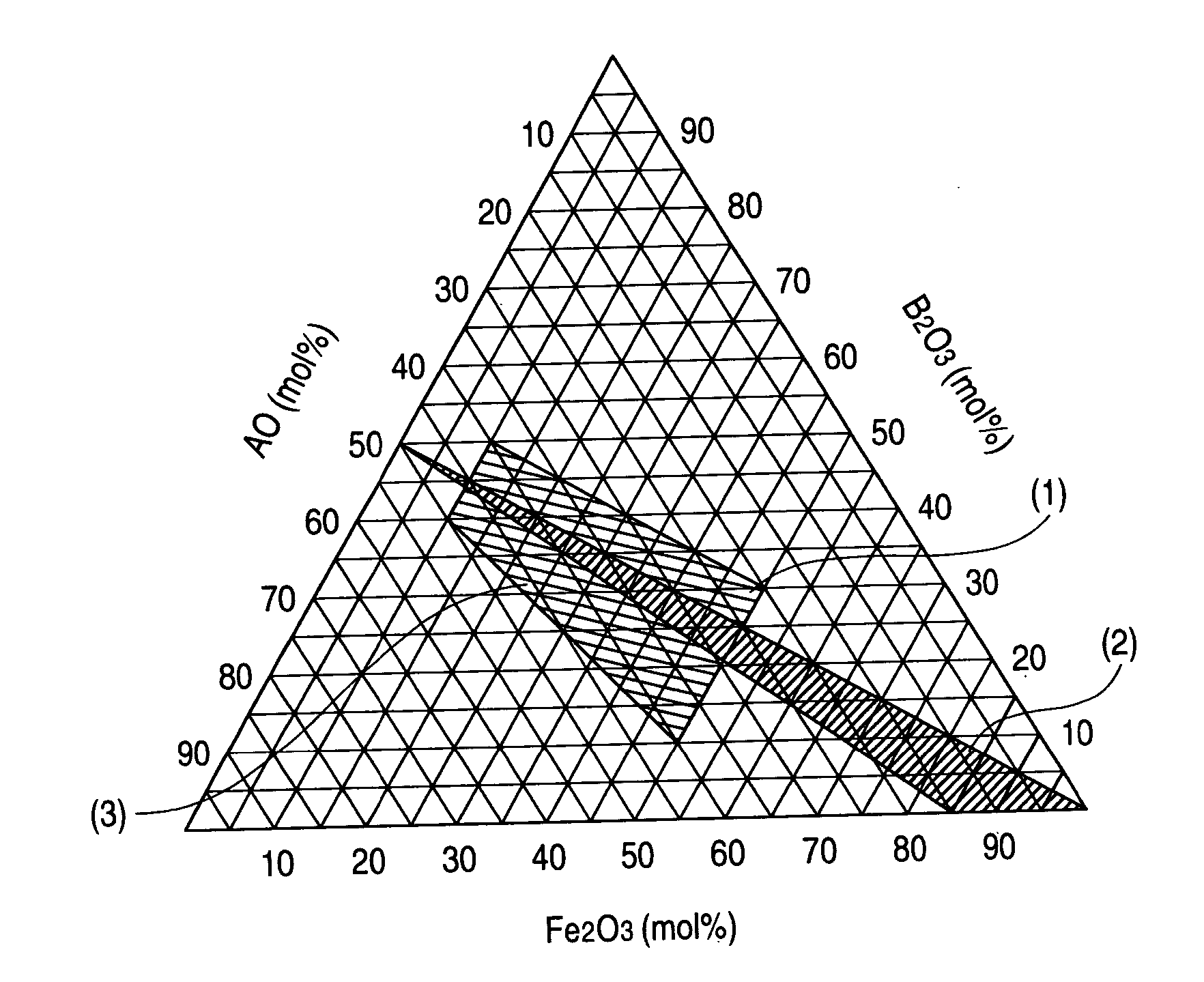Hexagonal ferrite magnetic powder, method for producing the same and magnetic recording medium
Active Publication Date: 2007-01-25
FUJIFILM CORP +1
View PDF7 Cites 104 Cited by
- Summary
- Abstract
- Description
- Claims
- Application Information
AI Technical Summary
Benefits of technology
[0077] The thickness of the non-magnetic layer is from 0.5 to 2.0 μm, preferably from 0.8 to 1.5 μm, more preferably from 0.8 to 1.2 μm. Additionally, the non-magnetic layer of the magnetic recording medium of the invention can exhibit its effect so long as it is essentially non-magnetic. For example, even when an impurity or an intentional trace amount of magnetic material is contained, the effect of the invention is exhibited by such essentially non-magnetic layer and the configuration can be seen as being essentially identical to that of the magnetic recording medium of the invention. Additionally, the term “essentially identical” as used herein means that the residual magnetic flux density of the non-magnetic layer is 10 mT or less or the coercive force is 7.96 kA / m (1000e) or less, with the absence of residual magnetic flux density and coercive force being preferred.
Problems solved by technology
However, the induction type magnetic head is becoming insufficient for use in the presently required reproduction of high-density records.
That is, when the number of coil turns of a reproduction head is increased in order to obtain a larger reproduction output, there results an increased inductance and an increase in resistance in high frequency region, leading to a problem of reduction in reproduction output.
However, these related techniques have failed to provide a magnetic recording medium adapted for a high-density recording as high as about 1 Gbpsi, which is a presently required level.
Method used
the structure of the environmentally friendly knitted fabric provided by the present invention; figure 2 Flow chart of the yarn wrapping machine for environmentally friendly knitted fabrics and storage devices; image 3 Is the parameter map of the yarn covering machine
View moreImage
Smart Image Click on the blue labels to locate them in the text.
Smart ImageViewing Examples
Examples
Experimental program
Comparison scheme
Effect test
examples
[0092] The invention is described in more detail below by reference to Examples and Comparative Examples which, however, do not limit the invention.
the structure of the environmentally friendly knitted fabric provided by the present invention; figure 2 Flow chart of the yarn wrapping machine for environmentally friendly knitted fabrics and storage devices; image 3 Is the parameter map of the yarn covering machine
Login to View More PUM
| Property | Measurement | Unit |
|---|---|---|
| Temperature | aaaaa | aaaaa |
| Temperature | aaaaa | aaaaa |
| Auxiliary magnetic field | aaaaa | aaaaa |
Login to View More
Abstract
A hexagonal ferrite magnetic powder having an average tabular diameter of from 15 to 28 nm, a coercive force (Hc) of from 2,000 to 5,000 Oe (from 160 to 400 kA / m), a switching field distribution (SFD) of from 0.3 to 0.7 and a D70 / D50 of from 1.05 to 1.25. This magnetic powder can be obtained by melting and quenching starting materials to obtain an amorphous product, and thermally treating the product, which comprises increasing a temperature at a rate of 300 to 500° C. / hr in a temperature range of 550 to 600° C. in the thermal treatment before the temperature reaches the thermally treating temperature.
Description
BACKGROUND OF THE INVENTION [0001] 1. Field of the Invention [0002] The present invention relates to a hexagonal ferrite magnetic powder, a method for producing the same and a magnetic recording medium. More particularly, it relates to a hexagonal ferrite magnetic powder which provides good output characteristics and yields a reduced noise and which is adapted for a magnetic recording medium for high-density recording reproducible by a highly sensitive head such as an MR head or a GMR head. Also, the invention relates to a magnetic recording medium containing the hexagonal ferrite magnetic powder in the magnetic layer. [0003] 2. Description of the Related Art [0004] In the field of magnetic recording, a magnetic head based on the principle of electromagnetic induction (induction type magnetic head) has been used and spread. However, the induction type magnetic head is becoming insufficient for use in the presently required reproduction of high-density records. That is, when the numb...
Claims
the structure of the environmentally friendly knitted fabric provided by the present invention; figure 2 Flow chart of the yarn wrapping machine for environmentally friendly knitted fabrics and storage devices; image 3 Is the parameter map of the yarn covering machine
Login to View More Application Information
Patent Timeline
 Login to View More
Login to View More IPC IPC(8): G11B5/708H01F1/00
CPCB82Y30/00Y10T428/2982C01P2004/64C01P2006/12C01P2006/19C01P2006/42C04B35/2633C04B35/265C04B35/62665C04B35/632C04B35/63456C04B2235/3215C04B2235/3217C04B2235/3251C04B2235/3275C04B2235/3284C04B2235/3409C04B2235/5409C04B2235/5454C04B2235/549C04B2235/767C04B2235/96G11B5/70678G11B5/714H01F1/113C01G49/0018
Inventor YAMAZAKI, NOBUOTAKAHASHI, MASATOSHIMANABE, AKIRASUZUKI, HIROYUKI
Owner FUJIFILM CORP
Features
- R&D
- Intellectual Property
- Life Sciences
- Materials
- Tech Scout
Why Patsnap Eureka
- Unparalleled Data Quality
- Higher Quality Content
- 60% Fewer Hallucinations
Social media
Patsnap Eureka Blog
Learn More Browse by: Latest US Patents, China's latest patents, Technical Efficacy Thesaurus, Application Domain, Technology Topic, Popular Technical Reports.
© 2025 PatSnap. All rights reserved.Legal|Privacy policy|Modern Slavery Act Transparency Statement|Sitemap|About US| Contact US: help@patsnap.com


